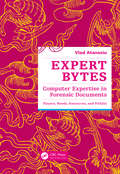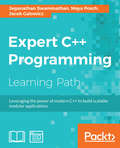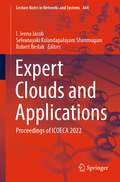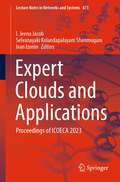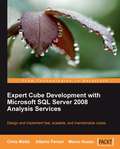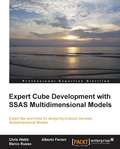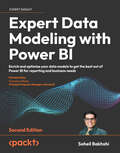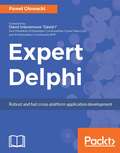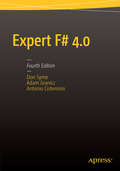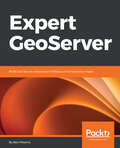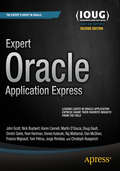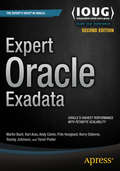- Table View
- List View
Expert Android Programming
by Prajyot MainkarBecome a pro with the latest Android SDK and create state of the art applications for Android. About This Book • Dive deep into Android development with practical hands on examples to help you in each stage. • Develop smart professional grade apps for the latest Android N version and become a pro android developer. • Unclog your development highway by utilising the industry standard best practices techniques. Who This Book Is For This book is for mobile developers having some expertise in building android apps and who wish to now take a leap into building complex app such as Zomato, using latest Android N power of Google. What You Will Learn • Building UI/UX following best industry practices • Development of Zomato Clone • Measure and improve app performance • Improving app using test mechanisms • Bringing the app live on the play store In Detail Android O brings a number of important changes for the users as well as the developers. If you want to create smart android applications which are fast, lightweight and also highly efficient then this is the book that will solve all your problems. You will create a complex enterprise grade app in this book. You will get a quick refresher of the latest android SDK and how to configure your development environment. Then you will move onto creating app layouts, component and module building, creating smart and efficient UIs. The most important part of a modern day app is how real time they are. With this book, you will create a smooth back-end for your app, ensure dynamic and real time communication between different app layers. As we move on, you will learn to leverage the different Android APIs and create an efficient SQLite data layer for your apps. You will implement effective testing techniques to make your app reliable and robust and finally you will learn to deploy it efficiently. The multiple stages of android development will also be simplified by giving you an industry standard set of best practices. Style and approach This book will have a dedicated practical tutorial style approach with focus on professional & enterprise grade android app development. The examples in each chapter will be modular and will also help you to create a complete fully fueatured android app by the end of the book.
Expert Android Studio
by Murat Yener Onur DundarTake your Android programming skills to the next level by unleashing the potential of Android Studio Expert Android Studio bridges the gap between your Android programing skills with the provided tools including Android Studio, NDK, Gradle and Plugins for IntelliJ Idea Platform. Packed with best practices and advanced tips and techniques on Android tools, development cycle, continuos integration, release management, testing, and performance, this book offers professional guidance to experienced developers who want to push the boundaries of the Android platform with the developer tools. You'll discover how to use the tools and techniques to unleash your true potential as a developer. Discover the basics of working in Android Studio and Gradle, as well as the application architecture of the latest Android platform Understand Native Development Kit and its integration with Android Studio Complete your development lifecycle with automated tests, dependency management, continuos integration and release management Writing your own Gradle plugins to customize build cycle Writing your own plugins for Android Studio to help your development tasks. Expert Android Studio is a tool for expert and experienced developers who want to learn how to make use of the tools while creating Android applications for use on mobile devices.
Expert Angular
by Sridhar Rao Mathieu Nayrolles Rajesh GunasundaramLearn everything you need to build highly scalable, robust web applications using Angular release 4 About This Book • Apply best practices and design patterns to achieve higher scalability in your Angular applications • Understand the latest features of Angular and create your own components • Get acquainted with powerful, advanced techniques in Angular to build professional web applications Who This Book Is For This book is for JavaScript developers with some prior exposure to Angular, at least through basic examples. We assume that you've got working knowledge of HTML, CSS, and JavaScript. What You Will Learn • Implement asynchronous programming using Angular • Beautify your application with the UI components built to the material design specification • Secure your web application from unauthorized users • Create complex forms, taking full advantage of 2-way data binding • Test your Angular applications using the Jasmine and Protractor frameworks for better efficiency • Learn how to integrate Angular with Bootstrap to create compelling web applications • Use Angular built-in classes to apply animation in your app In Detail Got some experience of Angular under your belt? Want to learn everything about using advanced features for developing websites? This book is everything you need for the deep understanding of Angular that will set you apart from the developer crowd. Angular has introduced a new way to build applications. Creating complex and rich web applications, with a lighter resource footprint, has never been easier or faster. Angular is now at release 4, with significant changes through previous versions. This book has been written and tested for Angular release 4. Angular is a mature technology, and you'll likely have applications built with earlier versions. This book starts by showing you best practices and approaches to migrating your existing Angular applications so that you can be immediately up-to-date. You will take an in-depth look at components and see how to control the user journey in your applications by implementing routing and navigation. You will learn how to work with asynchronous programming by using Observables. To easily build applications that look great, you will learn all about template syntax and how to beautify applications with Material Design. Mastering forms and data binding will further speed up your application development time. Learning about managing services and animations will help you to progressively enhance your applications. Next you'll use native directives to integrate Bootstrap with Angular. You will see the best ways to test your application with the leading options such as Jasmine and Protractor. At the end of the book, you'll learn how to apply design patterns in Angular, and see the benefits they will bring to your development. Style and approach This book provides comprehensive coverage of all aspects of development with Angular. You will learn about all the most powerful Angular concepts, with examples and best practices. This book is everything you need for the deep understanding of Angular that will set you apart from the developer crowd.
Expert Bytes: Computer Expertise in Forensic Documents - Players, Needs, Resources and Pitfalls
by Vlad AtanasiuExpert Bytes: Computer Expertise in Forensic Documents Players, Needs, Resources and Pitfallsintroduces computer scientists and forensic document examiners to the computer expertise of forensic documents and assists them with the design of research projects in this interdisciplinary field. This is not a textbook on how to perform the actua
Expert C++ Programming: Leveraging the power of modern C++ to build scalable modular applications
by Maya Posch Jacek GalowiczDeveloping expert level application development skills with C++Key Features- Take advantage of the myriad of features and possibilities that C++ offers to build real-world applications- Delve into the fundamentals of multithreading and concurrency and find out how to implement them- Learn the latest features of C++ and how to write better code by using the Standard Library Book DescriptionC++ has come a long way and has now been adopted in several contexts. Its key strengths are its software infrastructure and resource-constrained applications. The C++ 17 release will change the way developers write code, and this course will help you master your developing skills with C++. With real-world, practical examples explaining each concept, the course is divided into three modules where will begin by introducing you to the latest features in C++ 17. It encourages clean code practices in C++ in general and demonstrates the GUI app-development options in C++. You’ll get tips on avoiding memory leaks using smart-pointers. In the next module, you’ll see how multi-threaded programming can help you achieve concurrency in your applications. We start with a brief introduction to the fundamentals of multithreading and concurrency concepts. We then take an in-depth look at how these concepts work at the hardware-level as well as how both operating systems and frameworks use these low-level functions. You will learn about the native multithreading and concurrency support available in C++ since the 2011 revision, synchronization and communication between threads, debugging concurrent C++ applications, and the best programming practices in C++.Moving on, you’ll get an in-depth understanding of the C++ Standard Template Library. Where we show implementation-specific, problem-solution approach that will help you quickly overcome hurdles. You will learn the core STL concepts, such as containers, algorithms, utility classes, lambda expressions, iterators, and more while working on practical real-world recipes. These recipes will help you get the most from the STL and show you how to program in a better way.Jeganathan Swaminathan : Mastering C++ ProgrammingMaya Posch : Mastering C++ MultithreadingJacek Galowicz : C++17 STL CookbookWhat you will learn Write modular C++ applications in terms of the existing and newly introduced features Identify code-smells, clean up, and refactor legacy C++ applications Leverage the possibilities provided by Cucumber and Google Test/Mock to automate test casesDeep dive into the details of the how various operating systems currently implement multithreading Choose the best multithreading APIs when designing a new application Explore the use of mutexes, spin-locks, and other synchronization concepts and see how to safely pass data between threads Work with strings the STL way instead of handcrafting C-style code Understand standard support classes for concurrency and synchronization, and how to put them to work Use the filesystem library addition available with the C++17 STLWho this book is forThis course is for intermediate to advanced level C++ developers who want to get the most out of C++ to build concurrent and scalable application.
Expert C++: Become a proficient programmer by learning coding best practices with C++17 and C++20's latest features
by Vardan Grigoryan Shunguang WuDesign and architect real-world scalable C++ applications by exploring advanced techniques in low-level programming, object-oriented programming (OOP), the Standard Template Library (STL), metaprogramming, and concurrency Key Features Design professional-grade, maintainable apps by learning advanced concepts such as functional programming, templates, and networking Apply design patterns and best practices to solve real-world problems Improve the performance of your projects by designing concurrent data structures and algorithms Book Description C++ has evolved over the years and the latest release – C++20 – is now available. Since C++11, C++ has been constantly enhancing the language feature set. With the new version, you'll explore an array of features such as concepts, modules, ranges, and coroutines. This book will be your guide to learning the intricacies of the language, techniques, C++ tools, and the new features introduced in C++20, while also helping you apply these when building modern and resilient software. You'll start by exploring the latest features of C++, and then move on to advanced techniques such as multithreading, concurrency, debugging, monitoring, and high-performance programming. The book will delve into object-oriented programming principles and the C++ Standard Template Library, and even show you how to create custom templates. After this, you'll learn about different approaches such as test-driven development (TDD), behavior-driven development (BDD), and domain-driven design (DDD), before taking a look at the coding best practices and design patterns essential for building professional-grade applications. Toward the end of the book, you will gain useful insights into the recent C++ advancements in AI and machine learning. By the end of this C++ programming book, you'll have gained expertise in real-world application development, including the process of designing complex software. What you will learn Understand memory management and low-level programming in C++ to write secure and stable applications Discover the latest C++20 features such as modules, concepts, ranges, and coroutines Understand debugging and testing techniques and reduce issues in your programs Design and implement GUI applications using Qt5 Use multithreading and concurrency to make your programs run faster Develop high-end games by using the object-oriented capabilities of C++ Explore AI and machine learning concepts with C++ Who this book is for This C++ book is for experienced C++ developers who are looking to take their knowledge to the next level and perfect their skills in building professional-grade applications.
Expert Clouds and Applications: Proceedings of ICOECA 2021 (Lecture Notes in Networks and Systems #209)
by Francisco M. Gonzalez-Longatt I. Jeena Jacob Selvanayaki Kolandapalayam Shanmugam Ivan IzoninThis book features original papers from International Conference on Expert Clouds and Applications (ICOECA 2021), organized by GITAM School of Technology, Bangalore, India during February 18–19, 2021. It covers new research insights on artificial intelligence, big data, cloud computing, sustainability, and knowledge-based expert systems. The book discusses innovative research from all aspects including theoretical, practical, and experimental domains that pertain to the expert systems, sustainable clouds, and artificial intelligence technologies.
Expert Clouds and Applications: Proceedings of ICOECA 2022 (Lecture Notes in Networks and Systems #444)
by Robert Bestak I. Jeena Jacob Selvanayaki Kolandapalayam ShanmugamThe book features original papers from International Conference on Expert Clouds and Applications (ICOECA 2022), organized by GITAM School of Technology, Bangalore, India, during 3–4 February 2022. It covers new research insights on artificial intelligence, big data, cloud computing, sustainability, knowledge-based expert systems. The book discusses innovative research from all aspects including theoretical, practical, and experimental domains that pertain to the expert systems, sustainable clouds, and artificial intelligence technologies.
Expert Clouds and Applications: Proceedings of ICOECA 2023 (Lecture Notes in Networks and Systems #673)
by I. Jeena Jacob Selvanayaki Kolandapalayam Shanmugam Ivan IzoninThe book features original papers from International Conference on Expert Clouds and Applications (ICOECA 2023), organized by RV Institute of Technology and Management, Bangalore, India, during February 9–10, 2023. It covers new research insights on artificial intelligence, big data, cloud computing, sustainability, and knowledge-based expert systems. The book discusses innovative research from all aspects including theoretical, practical, and experimental domains that pertain to the expert systems, sustainable clouds, and artificial intelligence technologies. The thrust of the book is to showcase different research chapters dealing with the design, development, implementation, testing and analysis of intelligent systems, and expert clouds, and also to provide empirical and practical guidelines for the development of such systems.
Expert Consolidation in Oracle Database 12c
by Martin BachExpert Consolidation in Oracle Database 12c is your key to reducing data management costs and increasing data center efficiency. Consolidation and cloud computing are converging trends sweeping the industry. The same technologies enabling cloud computing enable consolidation as well, leading to savings on all fronts from the amount of power used for servers to the amount of floor space consumed to the number of administrators needed to manage an installation. Yet the consolidation process can be a long and winding road. Success requires planning, and consideration to the impacts on supporting infrastructure. Expert Consolidation in Oracle Database 12c guides you through planning and implementing a consolidated Oracle Database installation using the many new features built into the latest release of Oracle's database management system. You'll learn to identify candidates for consolidation and to recognize instances that are best left stand-alone. The book guides in working with clustered systems and ASM storage in the consolidated environment. Focus is given to Oracle Enterprise Manager 12c Cloud Control as a monitoring and management dashboard. Always the goal is to drive towards a cost-effective environment that is efficient both in technology and people. Focuses on the new consolidation features in Oracle Database 12c Helps you evaluate and correctly decide when to consolidate Leads to cost savings and improved data center efficiency What you'll learn Master the new consolidation and cloud features in Oracle Database 12c Correctly decide when to consolidate and when to remain standalone Reduce cost by reducing demand for rack space, power, and floor space Streamline administration with Oracle Enterprise Manager 12c Cloud Control Ensure the correct supporting infrastructure for a rock-solid environment Safeguard your new consolidate infrastructure from disaster and data loss Who this book is for Expert Consolidation in Oracle Database 12c is aimed at database administrators involved in consolidation efforts, or who are interested in exploring Oracle Database 12c's strong support for consolidation and cloud computing. Table of Contents 1. Consolidation as an Industry Trend 2. Oracle 12c New Features 3. Supporting Hardware 4. Supporting Software 5. Installing Oracle Linux 6. Installing Oracle Database 7. Pluggable Databases 8. Monitoring the Hosting Platform 9. Learning About Data Guard 10. Implementing Data Guard 11. Backup and Recovery 12. Upgrading to Oracle 12c
Expert Cube Development with Microsoft SQL Server 2008 Analysis Services
by Marco Russo Alberto Ferrari Chris WebbThis is a practical tutorial for Analysis Services that shows readers how to solve problems commonly encountered while designing cubes, and explains which features of Analysis Services work well and which should be avoided. The book walks through the whole cube development lifecycle, from building dimensions, cubes and calculations to tuning and moving the cube into production. This book is aimed at Analysis Services developers who already have some experience but who want to go into more detail on advanced topics, and who want to learn best practices for cube design.
Expert Cube Development with SSAS Multidimensional Models
by Marco Russo Alberto Ferrari Chris WebbAn easy-to-follow guide full of hands on examples of real-world Analysis Services cube development tasks. Each topic is explained and placed in context, and for the more inquisitive reader, there also more in-depth details of the concepts used. If you are an Analysis Services cube designer wishing to learn more advanced topic and best practices for cube design, this book is for you.You are expected to have some prior experience with Analysis Services cube development.
Expert Data Modeling with Power BI: Enrich and optimize your data models to get the best out of Power BI for reporting and business needs, 2nd Edition
by Soheil Bakhshi Christian WadeTake your Power BI reports to the next level by learning various data modeling techniques and leveraging the latest features of Power BI effectivelyPurchase of the print or Kindle book includes a free eBook in PDF format.Key FeaturesGet an understanding of data modeling techniques using Power BI with this up-to-date guideLearn how to define the relationships between data sets to extract valuable insightsExplore best practices for data preparation and modeling and build optimal data models to solve a wide variety of real-world business challengesBook DescriptionThis book is a comprehensive guide to understanding the ins and outs of data modeling and how to create full-fledged data models using Power BI confidently. In this new, fully updated edition, you'll learn how to connect data from multiple sources, understand data, define and manage relationships between data, and shape data models to gain deep and detailed insights about your organization. As you advance through the chapters, the book will demonstrate how to prepare efficient data models in the Power Query Editor and use simpler DAX code with new data modeling features. You'll explore how to use the various data modeling and navigation techniques and perform custom calculations using the modeling features with the help of real-world examples. Finally, you'll learn how to use some new and advanced modeling features to enhance your data models to carry out a wide variety of complex tasks. Additionally, you'll learn valuable best practices and explore common data modeling complications and the solutions to supercharge the process of creating a data model in Power BI and build better-performing data models. By the end of this Power BI book, you'll have gained the skills you need to structure data coming from multiple sources in different ways to create optimized data models that support high-performing reports and data analytics.What you will learnImplement virtual tables and time intelligence functionalities in DAX to build a powerful modelIdentify Dimension and Fact tables and implement them in Power Query EditorDeal with advanced data preparation scenarios while building Star SchemaDiscover different hierarchies and their common pitfallsUnderstand complex data models and how to decrease the level of model complexity with different approachesLearn advanced data modeling techniques such as calculation groups, aggregations, incremental refresh, RLS/OLS, and moreGet well-versed with datamarts and dataflows in PowerBIWho this book is forThis MS Power BI book is for BI users, data analysts, and analysis developers who want to become well-versed with data modeling techniques to make the most of Power BI. Basic working knowledge of Power BI and the Star Schema functionality are required to help you to understand the concepts covered in this book.
Expert Data Modeling with Power BI: Get the best out of Power BI by building optimized data models for reporting and business needs
by Soheil Bakhshi Christian WadeManage and work with business data effectively by learning data modeling techniques and leveraging the latest features of Power BIKey FeaturesUnderstand data modeling techniques to get the best out of data using Power BIDefine the relationships between data to extract valuable insightsSolve a wide variety of business challenges by building optimal data modelsBook DescriptionThis book is a comprehensive guide to understanding the ins and outs of data modeling and how to create data models using Power BI confidently.You'll learn how to connect data from multiple sources, understand data, define and manage relationships between data, and shape data models to gain deep and detailed insights about your organization.In this book, you'll explore how to use data modeling and navigation techniques to define relationships and create a data model before defining new metrics and performing custom calculations using modeling features. As you advance through the chapters, the book will demonstrate how to create full-fledged data models, enabling you to create efficient data models and simpler DAX code with new data modeling features. With the help of examples, you'll discover how you can solve business challenges by building optimal data models and changing your existing data models to meet evolving business requirements. Finally, you'll learn how to use some new and advanced modeling features to enhance your data models to carry out a wide variety of complex tasks.By the end of this Power BI book, you'll have gained the skills you need to structure data coming from multiple sources in different ways to create optimized data models that support reporting and data analytics.What you will learnImplement virtual tables and time intelligence functionalities in DAX to build a powerful modelIdentify Dimension and Fact tables and implement them in Power Query EditorDeal with advanced data preparation scenarios while building Star SchemaExplore best practices for data preparation and modelingDiscover different hierarchies and their common pitfallsUnderstand complex data models and how to decrease the level of model complexity with different approachesLearn advanced data modeling techniques such as aggregations, incremental refresh, and RLS/OLSWho this book is forThis MS Power BI book is for BI users, data analysts, and analysis developers who want to become well-versed with data modeling techniques to make the most of Power BI. You'll need a solid grasp on basic use cases and functionalities of Power BI and Star Schema functionality before you can dive in.
Expert Data Visualization
by Jos DirksenBreathe life into your data by learning how to use D3.js V4 to visualize information About This Book • Create complex visualizations powered by D3.js and open data. • Provides an extensive set of visualizations that explore all the functionality provided by D3.js V4. • Shows how to set up an easy–to-use environment to create stunning visualizations. Who This Book Is For The typical target audience of this book is JavaScript developers, designers, and visual artists who have some basic JavaScript programming knowledge and who now want to master pro-level techniques to create interactive data visualizations using web standards which work on desktop as well as mobile devices. What You Will Learn • Learn how D3.js works to declaratively define visualizations. • Create charts from scratch by using SVG and the D3.js APIs • See how to prepare data for easy visualization using D3.js. • Visualize hierarchical data using chart types provided by D3.js • Explore the different options provided by D3.js to visualize linked data such as graphs. • Spice up your visualizations by adding interactivity and animations. • Learn how to use D3.js to visualize and interact with Geo- and Gis-related information sources. • Create visualization by streaming data over WebSockets In Detail Do you want to make sense of your data? Do you want to create interactive charts, data trees, info-graphics, geospatial charts, and maps efficiently? This book is your ideal choice to master interactive data visualization with D3.js V4. The book includes a number of extensive examples that to help you hone your skills with data visualization. Throughout nine chapters these examples will help you acquire a clear practical understanding of the various techniques, tools and functionality provided by D3.js. You will first setup your D3.JS development environment and learn the basic patterns needed to visualize your data. After that you will learn techniques to optimize different processes such as working with selections; animating data transitions; creating graps and charts, integrating external resources (static as well as streaming); visualizing information on maps; working with colors and scales; utilizing the different D3.js APIs; and much more. The book will also guide you through creating custom graphs and visualizations, and show you how to go from the raw data to beautiful visualizations. The extensive examples will include working with complex and realtime data streams, such as seismic data, geospatial data, scientific data, and more. Towards the end of the book, you will learn to add more functionality on top of D3.js by using it with other external libraries and integrating it with Ecmascript 6 and Typescript Style and approach This book will have a real–world, case-study approach, where you will be given data sets from different domains. These data sets will have different visualization goals; some might need 2D or 3D charts, some might need automated workflows, others might require interactive maps. While you fulfill these goals, you will learn different techniques and best practices, which will enable you to perform data visualization tasks on your own
Expert Delphi
by Pawel GlowackiBecome a developer superhero and build stunning cross-platform apps with Delphi About This Book • A one-stop guide on Delphi to help you build cross-platform apps • This book covers important concepts such as the FireMonkey library, shows you how to interact with the Internet of Things, and enables you to integrate with Cloud services • The code is explained in detail with observations on how to create native apps for Ios and Android with a single code base Who This Book Is For If you want to create stunning applications for mobile, desktop, the cloud, and the Internet of Things, then this book is for you. This book is for developers who would like to build native cross-platform apps with a single codebase for iOS and Android. A basic knowledge of Delphi is assumed, although we do cover a primer on the language. What You Will Learn • Understand the basics of Delphi and the FireMonkey application platform as well as the specifics of Android and iOS platforms • Complete complex apps quickly with access to platform features and APIs using a single, easy-to-maintain code base • Work with local data sources, including embedded SQL databases, REST servers, and Backend-as-a-Service providers • Take full advantage of mobile hardware capabilities by working with sensors and Internet of Things gadgets and devices • Integrate with cloud services and data using REST APIs and scalable multi-tier frameworks for outstanding multi-user and social experience • Architect and deploy powerful mobile back-end services and get super-productive by leveraging Delphi IDE agile functionality • Get to know the best practices for writing a high-quality, reliable, and maintainable codebase in the Delphi Object Pascal language In Detail Delphi is the most powerful Object Pascal IDE and component library for cross-platform native app development. It enables building natively compiled, blazingly fast apps for all major platforms including Android, iOS, Windows, Mac, and Linux. If you want to build server-side applications, create web services, and have clear GUIs for your project, then this book is for you. The book begins with a basic primer on Delphi helping you get accustomed to the IDE and the Object Pascal language and will then quickly move on to advanced-level concepts. Through this book, we'll help you understand the architecture of applications and will teach you the important concepts of the FireMonkey library, show you how to build server-side services, and enable you to interact with the Internet of Things. Towards the end, you will learn to integrate your app with various web services and deploy them. By the end of the book, you will be able to build powerful, cross-platform, native apps for iOS and Android with a single code base. Style and approach This book will help you build cross-platform mobile apps with Delphi using a step-by-step approach.
Expert F# 4.0
by Don Syme Adam Granicz Antonio CisterninoLearn from F#'s inventor to become an expert in the latest version of this powerful programming language so you can seamlessly integrate functional, imperative, object-oriented, and query programming style flexibly and elegantly to solve any programming problem. Expert F# 4. 0 will help you achieve unrivaled levels of programmer productivity and program clarity across multiple platforms including Windows, Linux, Android, OSX, and iOS as well as HTML5 and GPUs. F# 4. 0 is a mature, open source, cross-platform, functional-first programming language which empowers users and organizations to tackle complex computing problems with simple, maintainable, and robust code. Expert F# 4. 0 is: A comprehensive guide to the latest version of F# by the inventor of the language A treasury of F# techniques for practical problem-solving An in-depth case book of F# applications and F# 4. 0 concepts, syntax, and features Written by F#'s inventor and two major F# community members, Expert F# 4. 0 is a comprehensive and in-depth guide to the language and its use. Designed to help others become experts, the book quickly yet carefully describes the paradigms supported by F# language, and then shows how to use F# elegantly for a practical web, data, parallel and analytical programming tasks. The world's experts in F# show you how to program in F# the way they do! What you'll learn Explore F# and its features quickly and thoroughly in the introductory chapters Use F# with matching technologies including SQL, LINQ, ASP. NET and REST Build reactive, asynchronous, and distributed web applications with F# Interoperate with F# from other languages, especially C# Integrate data sources and services using F# 4. 0 Information-Rich Programming Test, profile, and performance tune F# applications Create mobile applications, both web and native Who this book is for Expert F# 4. 0 is for anyone interested in state-of-the-art programming for solving real-world problems. Programmers of all backgrounds will find it engrossing. For C#, Java and VB programmers, F# provides invaluable insights into the future of these languages. For lovers of Python, Ruby and other dynamic languages, F# shows how you can get most of the benefits of these languages while keeping strong types and good performance. For educators, F# is the answer to a decades-long prayer: a language based on strong computer science concepts that also excites and empowers, not just in the classroom, but also in the real world. Table of Contents 1. Introduction 2. Your First F# Program - Getting Started With F# 3. Introducing Functional Programming 4. Introducing Imperative Programming 5. Understanding Types in Functional Programming 6. Programming with Objects 7. Encapsulating and Organizing Your Code 8. Working with Textual Data 9. Working with Sequences and Structured Data 10. Data Analytics, Numeric Programming, and Charting 11. Reactive, Asynchronous, and Parallel Programming 12. Symbolic Programming with Structured Data 13. Integrating External Data and Services 14. Building Smart Web Applications 15. Visualization and Graphical User Interfaces 16. Language-Oriented Programmig 17. Libraries and Interoperability 18. Developing and Testing F# Code 19. Designing F# Libraries Appendix
Expert GeoServer: Build and secure advanced interfaces and interactive maps
by Ben MearnsA fast-paced guide to putting your GeoServer-based application into fast, user-friendly, and secure productionKey Features Resolve bottlenecks, optimize data stores, and cluster server resources Use identity management and authentication for a user-specific, secure web application Go beyond traditional web hosting to explore the full range of hosting options in the cloudBook DescriptionGeoServer is open source, server-side software written in Java that allows users to share and edit geospatial data. In this book, you'll start by learning how to develop a spatial analysis platform with web processing services. Then you'll see how to develop an algorithm by chaining together geospatial analysis processes, which you can share with anyone in the world. Next you'll delve into a very important technique to improve the speed of your map application—tile caching. Here, you'll understand how tile caching works, how to develop an effective tile cache-supported web service, and how to leverage tile caching in your OpenLayers web application.Further on, you'll explore important tweaks to produce a performant GeoServer-backed web mapping application. Moving on, you'll enable authentication on the frontend and backend to protect sensitive map data, and deliver sensitive data to your end user. Finally, you'll see how to put your web application into production in a secure and user-friendly way. You'll go beyond traditional web hosting to explore the full range of hosting options in the cloud, and maintain a reliable server instance.What you will learn Develop a WPS-processing service to allow web-based geospatial data processing Get to know important techniques to improve the speed of your web map application—tile caching, raster data optimization, and server clustering Find out which GeoServer settings resolve bottlenecks Develop an algorithm by chaining geospatial analysis processes together Put your application into production with hosting, monitoring, and automated backup and recovery Understand how to develop an effective tile cache-supported web service Master techniques that ensure resilient server deploymentWho this book is forThis book is for anyone who wants to learn about advanced interfaces, security, and troubleshooting techniques in GeoServer. A basic understanding of GeoServer is required
Expert JavaScript
by Mark E. DaggettExpert JavaScript is your definitive guide to understanding how and why JavaScript behaves the way it does. Master the inner workings of JavaScript by learning in detail how modern applications are made. In covering lesser-understood aspects of this powerful language and truly understanding how it works, your JavaScript code and programming skills will improve. You will learn about core fundamentals of JavaScript, including deep dives into functions, scopes, closures, and practical object-oriented code. Mark Daggett explains clearly how closures, events, and asynchronous code really operate, as well as conventions and concepts to write JavaScript in a clear, pragmatic style. Many of the changes in ECMAScript6 and its implications are all explained. You'll be introduced to modern workflow tools to make application development faster, more enjoyable, and ostensibly more profitable. You'll understand how to measure code quality and write more testable JavaScript, and finally you'll learn about real-world applications of JavaScript, including JavaScript-powered robots. JavaScript is one of the most powerful languages on the web today, and it is only getting stronger. This book will take you through the process of planning, coding, testing, profiling and finally releasing your application, at expert level. With more frameworks and more improvements than ever, now is the time to become an expert at JavaScript. Make this journey - use Expert JavaScript today. "
Expert Microsoft Teams Solutions: A guide to Teams architecture and integration for advanced end users and administrators
by Aaron Guilmette Yura Lee Grant Oliasani Angel AvilesWritten by Microsoft engineers, Expert Microsoft Teams Solutions covers in-depth topics in Teams that are not covered elsewhere and explores tasks that customers frequently rely on Microsoft Partners to accomplishKey FeaturesExtend the MS Teams experience with this practical guide from Microsoft's technical specialistsDiscover advanced Teams capabilities such as voice, governance, and Power Platform integrationGet to grips with planning resources for voice integration in TeamsBook DescriptionMicrosoft Teams is designed to improve collaboration and integrate components of SharePoint, Exchange, Power Platform, and voice calling into a single platform. Complete with step-by-step explanations of concepts, practical examples, and architecture guidance, you'll learn how to plan and deploy Teams for your organization. As you progress, you'll explore and understand the Teams platform as a whole, from architecture and collaboration through to apps and voice, with the help of examples. The book approaches Teams not only from an end-user perspective but also from an administrator's point of view. You'll be able to understand the challenges around modernization in your organization relating to adopting, implementing, and administering Teams and tackle them effectively. By helping you realize the potential of Teams as a platform, this book will enable you to set up and deploy Teams solutions, leading to modernization in your organization's chat and voice infrastructure. By the end of this book, you'll be able to design and implement the most important and exciting aspects of Microsoft Teams.What you will learnGain a clear understanding of Microsoft Teams architecture and deployment conceptsBecome well-versed with advanced Teams voice capabilitiesExplore best practices to extend the Teams experience to various apps through collaborationFocus on how to conduct effective meetings, including ad hoc, scheduled, channel, and live eventsIntegrate Power Apps and Power Automate with Microsoft TeamsUnderstand key governance and security concepts in administering Microsoft TeamsWho this book is forThe book is for intermediate-level and experienced Microsoft Teams IT professionals as well as for administrator roles. Intermediate-level knowledge of the Microsoft Teams platform is assumed.
Expert Oracle Application Express
by John Scott Doug Gault Nick Buytaert Karen Cannell Martin D'Souza Dimitri Gielis Roel Hartman Denes Kubicek Raj Mattamal Dan Mcghan Francis Mignault Tom Petrus Jorge Rimblas Christoph RuepprichExpert Oracle Application Express, 2nd Edition is newly updated for APEX 5. 0 and brings deep insight from some of the best APEX practitioners in the field today. You'll learn about important features in APEX 5. 0, and how those can be applied to make your development work easier and with greater impact on your business. Oracle Application Express (APEX) is an entirely web-based development framework that is built into every edition of Oracle Database. The framework rests upon Oracle's powerful PL/SQL language, enabling power users and developers to rapidly develop applications that easily scale to hundreds, even thousands of concurrent users. APEX has seen meteoric growth and is becoming the tool of choice for ad-hoc application development in the enterprise. The many authors of Expert Oracle Application Express, 2nd Edition build their careers around APEX. They know what it takes to make the product sing--developing secure applications that can be deployed globally to users inside and outside a large enterprise. The authors come together in this book to share some of their deepest and most powerful insights into solving the difficult problems surrounding globalization, configuration and lifecycle management, and more. New in this edition for APEX 5. 0 is coverage of Oracle REST Data Services, map integration, jQuery with APEX, and the new Page Designer. You'll learn about debugging and performance, deep secrets to customizing your application user interface, how to secure applications from intrusion, and about deploying globally in multiple languages. Expert Oracle Application Express, 2nd Edition is truly a book that will move you and your skillset a big step towards the apex of Application Express development. Contains all-new content on Oracle REST Data Services, jQuery in APEX, and map integration Addresses globalization and other concerns of enterprise-level development Shows how to customize APEX for your own application needs What you'll learn Build applications around Oracle REST Data Services Analyze data geographically using the built-in, map integration Deploy applications globally while respecting linguistic and cultural differences Customize applications by exploiting APEX's roots in PL/SQL Reduce the stress of managing application lifecycle and configuration Deploy new functionality through custom plug-ins Who this book is for Expert Oracle Application Express, 2nd Edition is aimed at APEX developers who seek the deepest possible knowledge of Oracle Application Express and how to develop with it. Readers should know and be proficient with APEX, and be prepared to expend some mental energy in absorbing the high-end material in this book. Table of Contents 1. APEX Builder, Denes Kubicek 2. Oracle REST Data Services, John Scott 3. Oracle APEX 5. 0 Charts Inside Out, Dimitri Gielis 4. Tabular Forms, Denes Kubicek 5. Team Development, Roel Hartman 6. Globalization, Francis Mignault 7. Debugging, Doug Gault 8. Dynamic Actions, Martin Giffy D'Souza 9. Lifecycle Management, Nick Buytaert 10. Plug-Ins, Dan McGhan 11. jQuery with APEX, Tom Petrus 12. Map Integration, Christoph Ruepprich 13. Themes and Templates, Jorge Rimblas 14. Report Printing, Karen Cannell
Expert Oracle Database Architecture
by Darl Kuhn Thomas KyteNow in its third edition, this best-selling book continues to bring you some of the best thinking on how to apply Oracle Database to produce scalable applications that perform well and deliver correct results. Tom Kyte and Darl Kuhn share a simple philosophy: "you can treat Oracle as a black box and just stick data into it, or you can understand how it works and exploit it as a powerful computing environment. " If you choose the latter, then you'll find that there are few information management problems that you cannot solve quickly and elegantly. This fully revised third edition covers the developments up to Oracle Database 12c. Significant new content is included surrounding Oracle's new cloud feature set, and especially the use of pluggable databases. Each feature is taught in a proof-by-example manner, not only discussing what it is, but also how it works, how to implement software using it, and the common pitfalls associated with it. Don't treat Oracle Database as a black-box. Get this book. Get under the hood. Turbo-charge your career. Revised to cover Oracle Database 12c Proof-by-example approach: Let the evidence be your guide Dives deeply into Oracle Database's most powerful features What you'll learn Develop an evidence-based approach to problem solving Manage transactions in highly concurrent environments Speed access to data through table and index design Manage files and memory structures for performance and reliability Scale up through partitioning and parallel processing Load and unload data to interface with external systems Who this book is for Expert Oracle Database Architecture is aimed at Oracle Database administrators, at PL/SQL and Java developers writing code to be deployed inside the database, and at developers of external applications who use Oracle Database as a data store. It is the go-to book for those wishing to create efficient and scalable applications. Table of Contents Developing Successful Oracle Applications Architecture Overview Files Memory Structures Oracle Processes Locking and Latching Concurrency and Multi-versioning Transactions Redo and Undo Database Tables Indexes Datatypes Partitioning Parallel Execution Data Loading and Unloading
Expert Oracle Database Architecture: Techniques and Solutions for High Performance and Productivity
by Darl Kuhn Thomas KyteNow in its fourth edition and covering Oracle Database 21c, this best-selling book continues to bring you some of the best thinking on how to apply Oracle Database to produce scalable applications that perform well and deliver correct results. Tom Kyte and Darl Kuhn share a simple philosophy: "you can treat Oracle as a black box and just stick data into it, or you can understand how it works and exploit it as a powerful computing environment." If you choose the latter, then you’ll find that there are few information management problems that you cannot solve quickly and elegantly.This fully revised fourth edition covers the developments and new features up to Oracle Database 21c. Up-to-date features are covered for tables, indexes, data types, sequences, partitioning, data loading, temporary tables, and more. All the examples are demonstrated using modern techniques and are executed in container and pluggable databases. The book’s proof-by-example approach encourages you to let evidence be your guide. Try something. See the result. Understand why the result is what it is. Apply your newfound knowledge with confidence. The book covers features by explaining how each one works, how to implement software using it, and the common pitfalls associated with it. Don’t treat Oracle Database as a black box. Get this book. Dive deeply into Oracle Database’s most powerful features that many do not invest the time to learn about. Set yourself apart from your competition and turbo-charge your career.What You Will LearnIdentify and effectively resolve application performance issues and bottlenecksArchitect systems to leverage the full power and feature set of Oracle’s database engineConfigure a database to maximize the use of memory structures and background processesUnderstand internal locking and latching technology and how it impacts your systemProactively recommend best practices around performance for table and index structuresTake advantage of advanced features such as table partitioning and parallel executionWho This Book Is ForOracle developers and Oracle DBAs. If you’re a developer and want a stronger understanding of Oracle features and architecture that will enable your applications to scale regardless of the workload, this book is for you. If you’re a DBA and want to intelligently work with developers to design applications that effectively leverage Oracle technology, then look no further.
Expert Oracle Enterprise Manager 12c
by Kellyn Pot'Vin Bobby Curtis Pete Sharman Alex Gorbachev Anand Akela Gokhan Atil Leighton Nelson Niall LitchfieldEnterprise Manager 12c (EM12c), Oracle's newest and fully-integrated enterprise management product, now provides a complete cloud lifecycle management solution and enterprise environment management interface. Expert Oracle Enterprise Manager 12c opens up the secrets of this incredible management tool, saving you time while enhancing your visibility as someone management can rely upon to deliver reliable database service in today's increasingly chaotic and change-driven IT environment. Expert Oracle Enterprise Manager 12c covers all the topics you demand and need to function effectively, from basic monitoring and configuration to advanced metric extensions and plugins. Real-life scenarios and demonstrations place you in the comfort zone of using the EM12c console, and the experienced author team provides deep understanding of the inner workings of this new Enterprise Manager. Database administrators and system administrators are expected to offer increasing levels of service for 24X7 systems and newer cloud environments. Em12c offers robust, end-to-end intelligent management of the complete environment. It includes direct, real-time integration with Oracle's online knowledgebase. Expert Oracle Enterprise Manager 12c helps you master this important tool and manage any challenge that comes your way. Provides example solutions to everyday problems through EM12c features. Explains the changes in EM12c, included trusted extensions. Focuses on advanced aspects of the EM12c interface.
Expert Oracle Exadata
by Kerry Osborne Martin Bach Karl Arao Andy Colvin Frits Hoogland Randy Johnson Tanel PoderExpert Oracle Exadata, 2nd Edition opens up the internals of Oracle's Exadata platform so that you can fully benefit from the most performant and scalable database hardware appliance capable of running Oracle Database. This edition is fully-updated to cover Exadata 5-2 and Oracle Database 12c. If you're new to Exadata, you'll soon learn that it embodies a change in how you think about and manage relational databases. A key part of that change lies in the concept of offloading SQL processing to the storage layer. In addition there is Oracle's engineering effort in creating a powerful platform for both consolidation and transaction processing. The resulting value proposition in the form of Exadata has truly been a game-changer. Expert Oracle Exadata, 2nd Edition provides a look at the internals and how the combination of hardware and software that comprise Exadata actually work. Authors include Martin Bach, Andy Colvin, and Frits Hoogland, with contributions from Karl Arao, and built on the foundation laid by Kerry Osborne, Randy Johnson, and Tanel Poder in the first edition. They share their real-world experience gained through a great many Exadata implementations, possibly more than any other group of experts today. Always their goal is toward helping you advance your career through success with Exadata in your own environment. This book is intended for readers who want to understand what makes the platform tick and for whom--"how" it does what it is does is as important as what it does. By being exposed to the features that are unique to Exadata, you will gain an understanding of the mechanics that will allow you to fully benefit from the advantages that the platform provides. This book changes how you think about managing SQL performance and processing. It provides a roadmap to successful Exadata implementation. And it removes the "black box" mystique. You'll learn how Exadata actually works and be better able to manage your Exadata engineered systems in support of your business. This book: Changes the way you think about managing SQL performance and processing Provides a roadmap to successful Exadata implementation Removes the "black box" mystique, showing how Exadata actually works What you'll learn Configure Exadata from the ground up Optimize for mixed OLTP/DW workloads Migrate large data sets from existing systems Connect Exadata to external systems Support consolidation strategies using the Resource Manager Configure high-availability features of Exadata, including Real Application Clusters (RAC) and automatic storage management (ASM) Apply tuning strategies utilizing the unique features of Exadata Who this book is for Expert Oracle Exadata, 2nd Edition is for database administrators and developers who want to understand what makes Exadata unique so that they can take advantage of all the platform has to offer. It is also for anyone who needs to plan and execute migrations of systems to the Exadata platform. Finally, the book will be invaluable to those who support and maintain such systems. Table of Contents What Is Exadata? Offloading / Smart Scan Hybrid Columnar Compression Storage Indexes Exadata Smart Flash Cache Exadata Parallel Operations Resource Management Configuring Exadata Recovering Exadata Exadata Wait Events Understanding Exadata Performance Metrics Monitoring Exadata Performance Migrating to Exadata Storage Layout Compute Node Layout Unlearning Some Things We Thought We Knew Patching Appendix A: CELLCL and DCLI Appendix B: Online Exadata Resources Appendix C: Diagnostic Scripts Appendix D: Exachk



